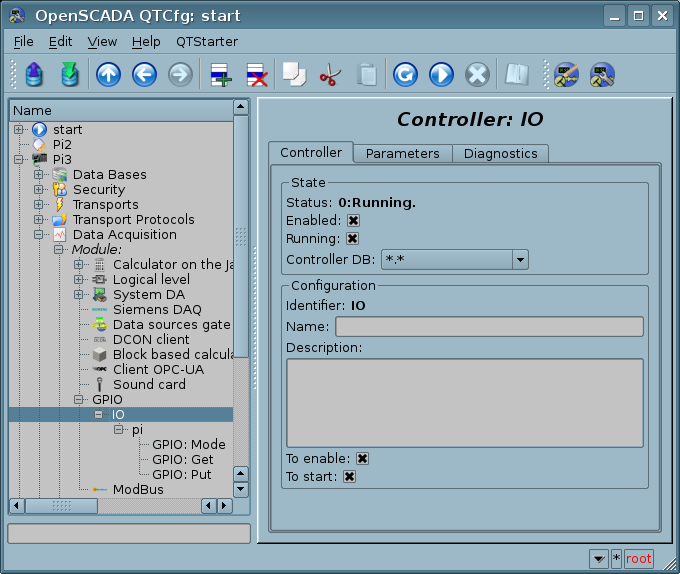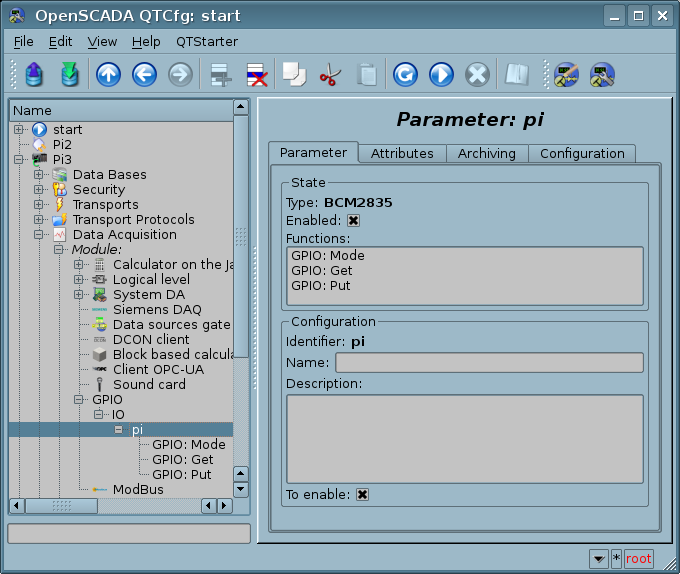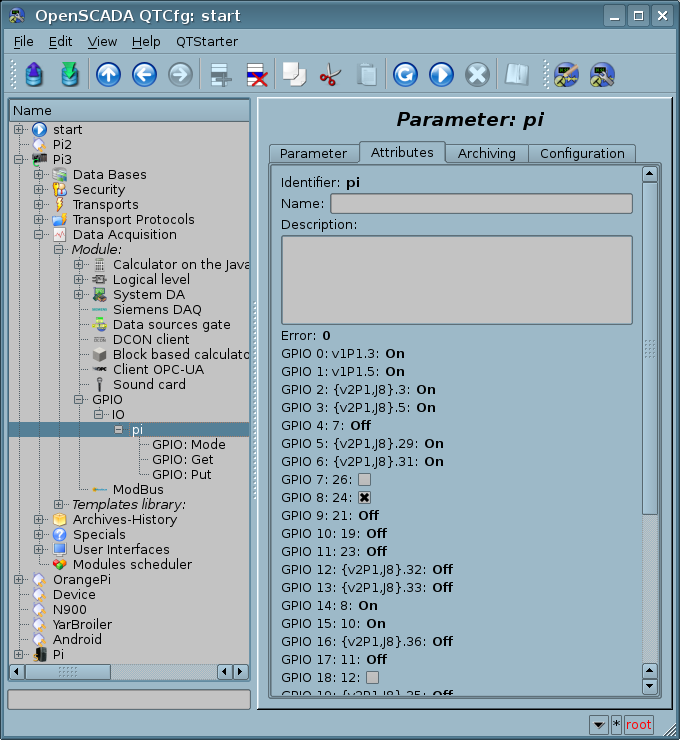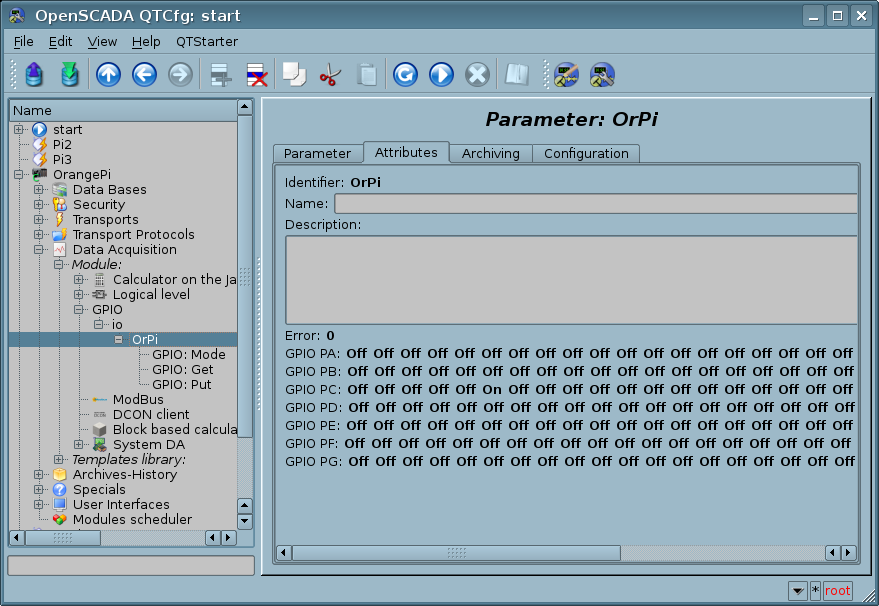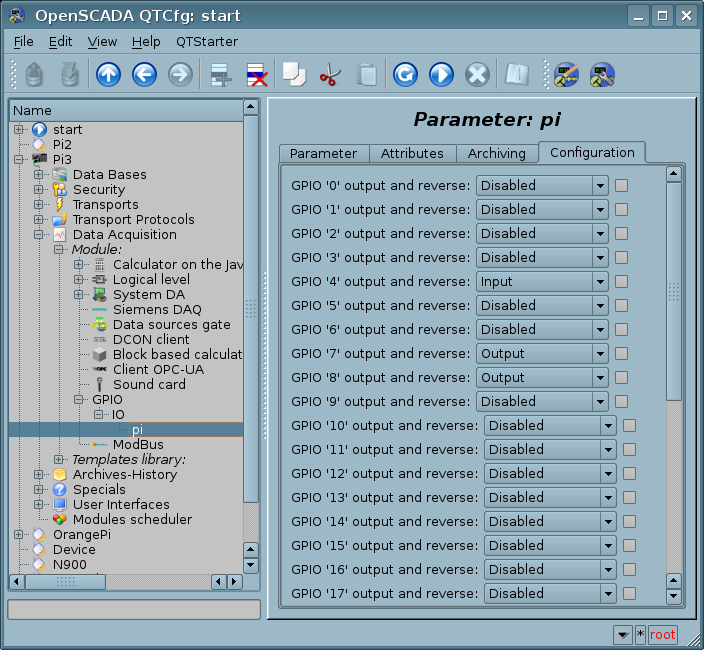| Module | Name | Version | License | Source | Languages | Platforms | Type | Author | Description |
|---|---|---|---|---|---|---|---|---|---|
| GPIO | GPIO | 2.1 | GPL2 | daq_GPIO.so | en,uk,ru,de | x86,x86_64,ARM | DAQ | Roman Savochenko | GPIO different single board PCs: Broadcom BCM 2835 and more (Raspberry Pi, ...), SUNXI AllWinner H2 and more (Orange Pi Zero, ...). |
Contents
The module provides OpenSCADA support for General Purpose Inputs/Outputs (GPIOs) based on single-board PCs:
- BCM2835 and higher — Raspberry PI, PI2, PI3;
- SUNXI AllWinner H2 and higher — Orange Pi, Zero, One, Plus.
GPIO on BCM2835 and higher of Raspberry Pi counts 32 pins in maximum, some of them can also performs alternative functions like to: I2C, UART, SPIO. For access to the GPIO there is used the GPIO part of the library libBCM2835, which are included and building with the module.
GPIO on SUNXI AllWinner H2 and higher of Orange Pi can have 9 main and 6 additional banks with 32 pins for each one, some of them can also performs alternative functions like to: I2C, UART, SPIO. For access to the GPIO there is used the GPIO part of the library orangepi_PC_gpio_pyH3, which are included and building with the module.
1 Controller object
GPIO in OpenSCADA is configured by creating a new controller object (Fig.1) and the controller parameter — one GPIO parameter for one card.
From this tab you can set:
- The state of the controller object, as follows: status, "Enabled", "Running" and the database name containing the configuration.
- Identifier, name and description of the controller.
- The state "Enabled" and "Running", in which the controller object must be switched at boot.
- Name of the table to store the controller parameters configuration.
2 Parameters (BCM2835, SUNXI)
The parameter is the direct representative-reflection of the GPIO, which contains a list of attributes of a discrete type in an amount that corresponds to this GPIO type. The parameter configuration tab is shown in Figure 2. The data collection is performed only in synchronous mode since the GPIO should be fast.
With the parameter configuration tab you can set:
- The state of the parameter: type (BCM2835, SUNXI), "Enabled" and static functions list.
- Identifier, name and description of the parameter.
- The state "Enabled", in which the parameter must be translated at start up.
The tab "Attributes" of GPIO is shown in Figure 3 for BCM2835, and Figure 4 for SUNXI. For the GPIO, the "Configuration" tab (Fig. 5) is also available with the IO mode and the inversion state.
For the fastest access to the GPIO, the parameter provides three static functions: "mode", "get" and "put". These functions can be used in the OpenSCADA programming environment for extraordinary interaction algorithms organization. To address the function, you can use the static call of the address GPIO.{cntr}.{prm}.{Func}() or the dynamic SYS.DAQ.GPIO.{cntr}.{prm}["{Func}"].call(). Where:
- {cntr} — identifier the controller object;
- {prm} — identifier the parameter object;
- {Func} — identifier the function.
At the moment, it is also possible to dynamically connect the static functions as the fastest and simultaneously flexible solution, for example:
function put = addr+".fnc_put";
if(put) {
put(D4, vl&0x10);
put(D5, vl&0x20);
put(D6, vl&0x40);
put(D7, vl&0x80);
}
And in this configurable way there for now have implemented next templates of the low-level devices:
2.1 Function GPIO: Mode (mode)
Description: GPIO mode, input or output.
Parameters:
| ID | Parameter | Type | Mode | By defaults |
|---|---|---|---|---|
| rez | Result | Integer | Return | |
| pin | Pin | Integer | Input | |
| set | Setting the input mode: 1-Input, 2-Input (pull up), 3-Input (pull down), 4-Output | Integer | Input | 0 |
2.2 Function GPIO: Get (get)
Description: GPIO get pin level.
Parameters:
| ID | Parameter | Type | Mode | By defaults |
|---|---|---|---|---|
| rez | Result | Bool | Return | |
| pin | Pin | Integer | Input |
2.3 Function GPIO: Put (put)
Description: GPIO put pin level.
Parameters:
| ID | Parameter | Type | Mode | By defaults |
|---|---|---|---|---|
| pin | Pin | Integer | Input | |
| val | Value | Bool | Input |
3 Notes
The module was tested on the boards Raspberry Pi 2,3 models B and Orange Pi Zero.
Access time to the static functions was measured comparing to the different methods which you can see here and the overall performance measurement is given in the following table:
| GPIO type | get(), us | put(), us |
|---|---|---|
| Raspberry Pi 3 | 0.36 | 0.27 |
| Orange Pi Zero | 1.2 | 1.2 |
